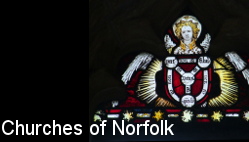
home I index I latest I glossary I introductions I e-mail I about this site
St Mary, Anmer
Follow these journeys as they happen at Last Of England Twitter.
| St Mary,
Anmer The sprawling sheep meadows of the vast Sandringham estate were among the poorest places in England by the mid-19th Century, but then the estate was bought by Queen Victoria for her wayward son the Prince of Wales to keep him out of trouble. The Prince, later Edward VII, put energy and money into not only rebuilding Sandringham House but also restoring the villages and churches of the estate, and one of these was Anmer. In fact, there isn't much of a village here at all. At the 1851 census, when the populations of rural Norfolk parishes were reaching a peak, there were just one hundred and sixty seven people living in the parish of Anmer, and it is unlikely that there are anywhere near that number today. All there is here now apart from a few cottages is the church and Anmer Hall, which we will come back to in a moment. The church sits near the end of the drive which leads to the Hall. When I first came this way twenty years ago it was a muddy track, but now it is a proper road. The derelict farm has also gone, and the signs direct you firmly into the car park above which the little church sits on a mound. The church was probably built in a single campaign from the late 13th to the early 14th Century, the tower coming a century later. However, it was all vigorously restored in the 1880s by Frederick Preedy, who found plenty of work in this area thanks to his friendship with the Le Stranges of Hunstanton Hall. Preedy largely rebuilt the chancel, although Pevsner thought the east window tracery was true to its original form. This restoration was ameliorated in the early 20th Century at the expense of Edward VII who had bought Anmer Hall and its park in 1896. This further reordering consisted of a complete High Church refurnishing of the chancel, nave and south chapel. As well as doing a tour of the outside of the church it is worth walking up to the top of the churchyard and looking back westwards. On a sunny day the view is one of the loveliest of any Norfolk church, especially when the birds are singing and the lambs are bouncing about around their mothers in the meadow beyond. You'll notice a locked gate here and a sign warning you of the provisions of section 18 of the Organised Crime and Police Act 2005. This is because since 2015 Anmer Hall has been the country home of William and Kate, the current Prince and Princess of Wales. If you linger too long at this end of the churchyard you may be sure that you are being watched, although the Royal Protection officer who stepped out of the bushes on my most recent visit was very friendly. The south porch leads into an intimate interior, with just enough light coming through the 14th Century windows to create a prayerful, hushed atmosphere. A screen has been placed partway up the nave, emphasising this intimacy, the western side of it forming a baptistery with mawkish glass under the tower by Ward & Hughes, which came as part of Preedy's restoration. Along the walls are six hatchments for the Calthorpe family, the previous owners of the Hall. The south transept chapel is separated from the nave by another screen, its furnishings Edwardian in the most exact sense of the word, for they were commissioned by Edward VII himself. The chancel opens beyond, full of light thanks to the lack of coloured glass. The altar has a Sarum screen, the curtains supported by riddel posts. Mortlock recalled that Anmer church had a been a particular favourite of Queen Mary, the wife of George V. She put energy and time into beautifying it, and in the years after she died in 1953 there began to be some concern that it had fallen into a state of neglect. However, a sympathetic restoration in 1986 put things right, although it did return the paintings by Sir Noel Paton from the chancel back to Sandringham House, from where Queen Mary had removed them. They're safer there, although it should be added that thanks to its neighbours this little church is better guarded than any other church in Norfolk, saving perhaps that of Sandringham itself. Simon Knott, April 2023 Follow these journeys as they happen at Last Of England Twitter. |
|
|||||||||||||||||||||||||||||||||||||||||||||||||||||||
home I index I latest I introductions I e-mail I about this site I glossary
links I small
print I www.simonknott.co.uk I www.suffolkchurches.co.uk
ruined churches I desktop backgrounds I round tower churches